It’s
a process of creating new words from material available in the
language after a certain structural and semantic formulas and
pattern, forming words by combining root & affix morphemes.
2 Types of word formation:
1)
Compounding (словосложение)
2)
Word – derivation
Within
the types further distinction may be made between the ways of forming
words. The basic way of forming words is word-derivation affixation
and conversion apart from this shortening and a number of minor ways
of formal words such as back-forming, blending, sound imitation are
traditionally referred to formation.
Different types of word
formation:
Affixation
is
the formation of new words by means of suffixes and prefixes to
stemsbasis.
Affixational
morphemes
include inflectional affixes or inflections and derivational affixes.
Inflections
carry only grammatical meaning and are thus relevant only for the
formation of word-forms. Derivational
affixes
are relevant for building various types of words. They are lexically
always dependent on the root which they modify. They possess the same
types of meaning as found in roots, most of them have the
part-of-speech meaning which makes them structurally the important
part of the word as they condition the lexico-grammatical class the
word belongs to. Due to this component of their meaning the
derivational affixes are classified into affixes building different
parts of speech: nouns, verbs, adjectives or adverbs.
Roots and
derivational affixes are generally easily distinguished and the
difference between them is clearly felt as, e.g., in the words
helpless,
handy, blackness, Londoner, refill,
etc.: the root-morphemes help-,
hand-, black-, London-, fill-,
are understood as the lexical centers of the words, and –less,
-y, -ness, -er, re-
are
felt as morphemes dependent on these roots.
Distinction is also made of
free and bound morphemes.
-
Word Formation: Compounding. Classification of compounds.
Compounding
& word comparison. Compound
words are made of 2 derivational stems. The types of structure of CW:
neutral,
morphological &syntactic.
In neutral
compound
the process is released without any linking elements sunflower.
There
are three types of neutral compounds simple compounds went a compound
consist of a simple affixes stems.
Derivate/
derivational compound
— has affixes babysitter.
Contracted
–
has a shorten stems. TV-set
Morphological
C –
few
in number. This type is non productive. Represented by words, where 2
stems are combined by a linking vowel/ consonant Anglo-Saxon,
statesman, craftsmanship.
Syntactic
C
– formed of segments of speech preserving articles, prepositions,
adverbs. Mother-in-law
-
Word Formation: Conversion, Blending, Shortening.
Conversion
(zero derivation) it is one of the major ways of enriching EV &
referrers to the numerous cases of phonetic identity of word forms of
2 words belonging to different part of speech.. The new word has a
meaning which differs from that of original one though it can ><
be associated with it. nurse
(noun) to nurse – to feed
A certain stem is used for the
formation of a categorically different word without a derivative
element being added.
Bag
– to bag, Back – to back , Bottle – to bottle This
specific pattern is very productive in English
The most
popular types are noun
→verb
or verb→noun
To
take off – a take off
Conversion
can be total
or partial.
Partial: the then
president (тогдашний).
An adverb is used as an adjective, only in this particular context.
Total: work
– to work
Conversion
may be the result of shading of English endings. The historical
changes may be briefly outlined as follows: in O.E. a verb and a noun
of the same root were distinguished by their endings. For ex: the
verb ‘to love’ had a form (Old Eng.) ‘lufian’. This verb had
personal conjunctions. The noun ‘love’ had the form ‘lufu’
with different case endings. But in the course of time, the personal
and case endings were lost. There are numerous pairs of words (e. g.
love, n. — to love, v.; work, n. — to work, v.; drink, n. — to
drink, v., etc.) which did, not occur due to conversion but coincided
as a result of certain historical processes (dropping of endings,
simplification of stems) when before that they had different forms
(e. g. O. E. lufu, n. — lufian, v.).
The
two categories of parts of speech especially affected by conversion
are nouns and verbs. Verbs made from nouns are the most numerous
amongst the words produced by conversion: e. g. to
hand, to back, to face, to eye, to mouth, to nose, to dog, to wolf,
to monkey, to can, to coal, to stage, to screen, to room, to floor,
to blackmail, to blacklist, to honeymoon,
and very many others.
Nouns are
frequently made from verbs: do (e. g. This
is the queerest do I»ve ever come across.
Do — event, incident), go (e. g. He
has still plenty of go at his age.
Go — energy), make,
run, find, catch, cut, walk, worry, show, move,
etc. Verbs can also be made from adjectives: to
pale, to yellow, to cool, to grey, to rough
(e. g. We
decided to rough it in the tents as the weather was warm),
etc.
Other parts
of speech are not entirely unsusceptible to conversion as the
following examples show: to
down, to out (as in a newspaper heading Diplomatist Outed from
Budapest), the ups and downs, the ins and outs, like, n, (as in the
like of me and the like of you).
Is
blending part of two words to form one word (merging into one word)
-
Smoke
+ fog = smog -
Breakfast
+ lunch = brunch -
Smoke
+ haze = smaze (дымка)
—
addictive type:
they are transformable into a phrase consisting of two words combined
by a conjunction “and”
-
smog
→ smoke & fog
—
blending of restrictive type:
transformable into an attributive phrase, where the first element
serves as modifier of a second.
-
Positron
– positive electron -
Medicare
– medical care
Shortening.
There
are 2 ways of producing them:
1. The word
is formed from the syllable of the original word which in term may
loose its beginning –phone,
its ending vac
(vacation) or
both
fridge.
2. The word
is formed from the initial letter of a word group BB,
bf – boyfriend. Acronyms are
shorten words but read as one UNO
[ju:nou]
Соседние файлы в предмете [НЕСОРТИРОВАННОЕ]
- #
- #
- #
- #
- #
- #
- #
- #
- #
- #
- #
Слайд 1
Minor types of word formation
Zinep Kurdau
EU-3-13
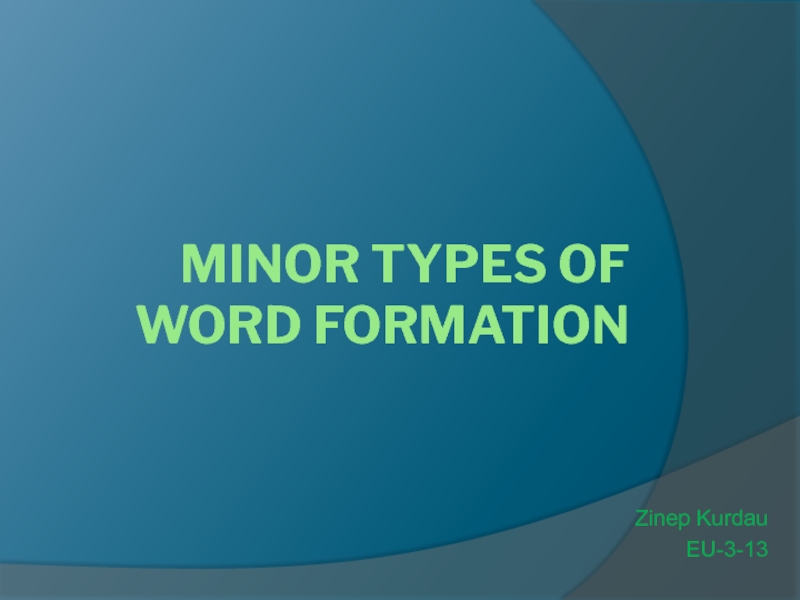
Слайд 2Minor types of word formation
Blending
Shortening
Reduplications
Back-formation
Sound-imitation
Sound-interchange
The stress distinction
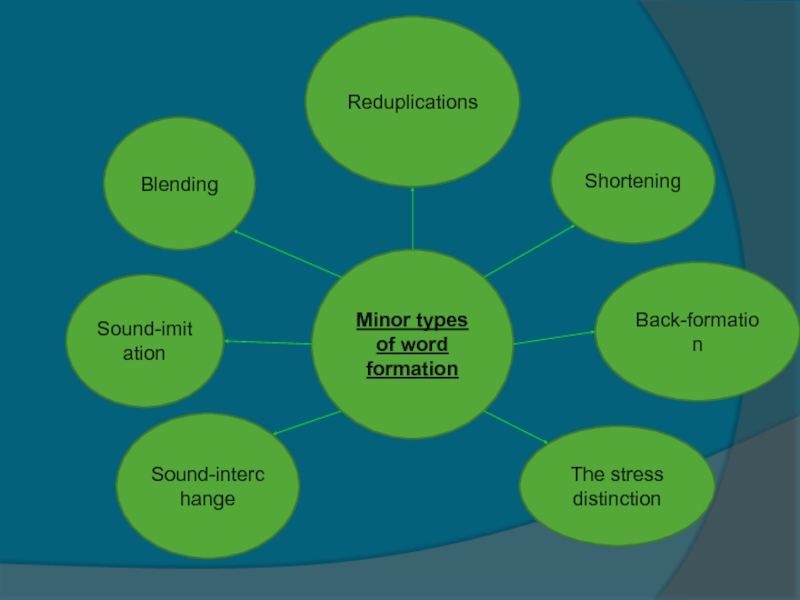
Слайд 3Shortening
the process and the result of forming a word out
of the initial elements (letters, morphemes) of a word combination
A
new word from a syllable
a new word from the initial letters of a word group
telephone – phone
refrigerator — fridge
U.N.O – United Nation Organization
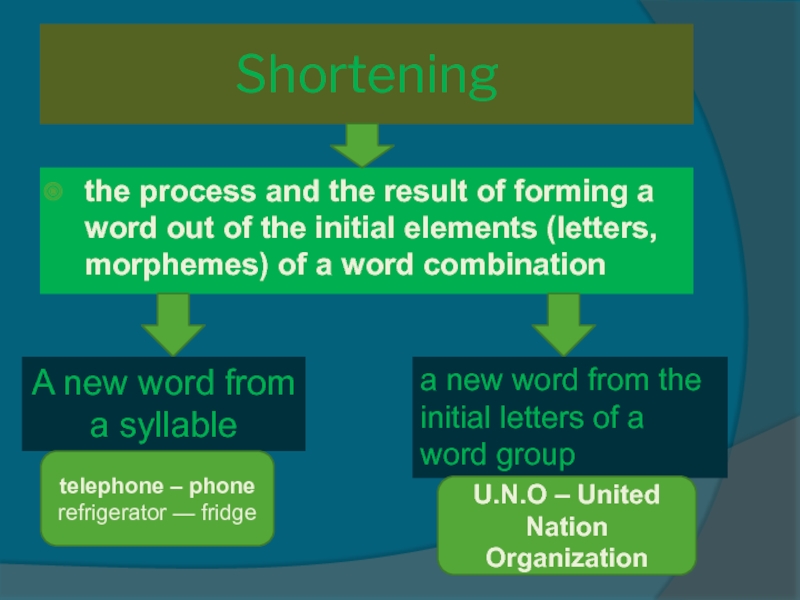
Слайд 4Blending
the process of combining parts of two words
to form one word
Smog=smoke + fog
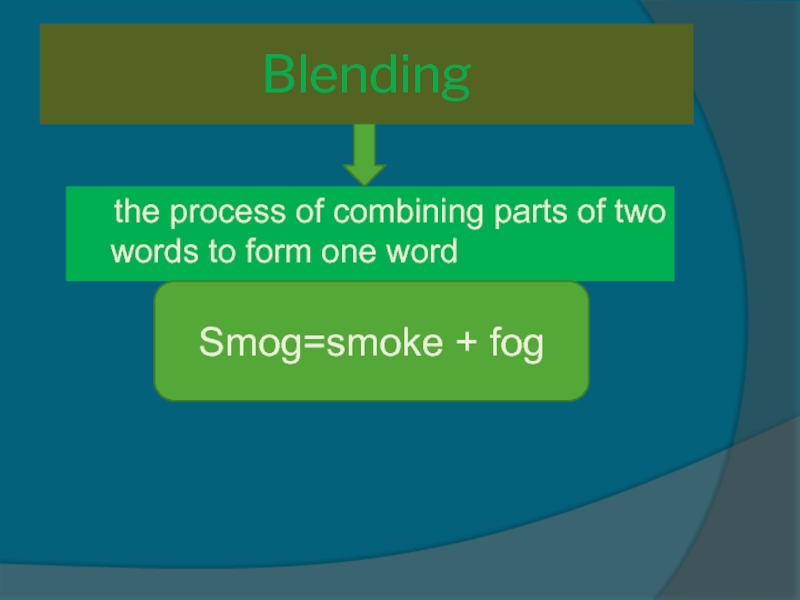
Слайд 5Sound-imitation
formation of words from sounds that resemble those associated with
the object or action to be named or that seem
suggestive of its qualities
The sound of the verbs to rush, to dash, to flash, may be said to reflect the brevity, swiftness and energetic nature of their corresponding actions.
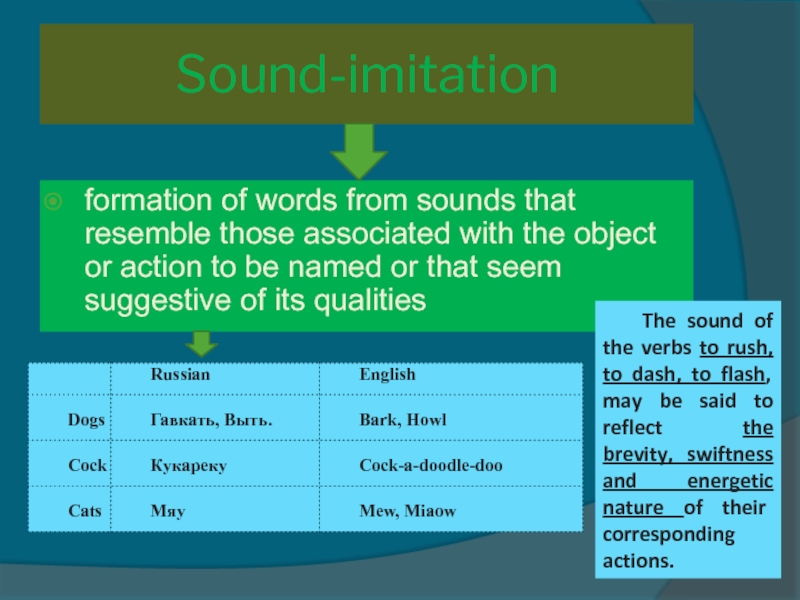
Слайд 6Reduplication
new words are made up by doubling a stem
without any
phonetic changes:
buy-buy
with a variation of the root-vowel or consonant:
ping-pong,
chit-chat
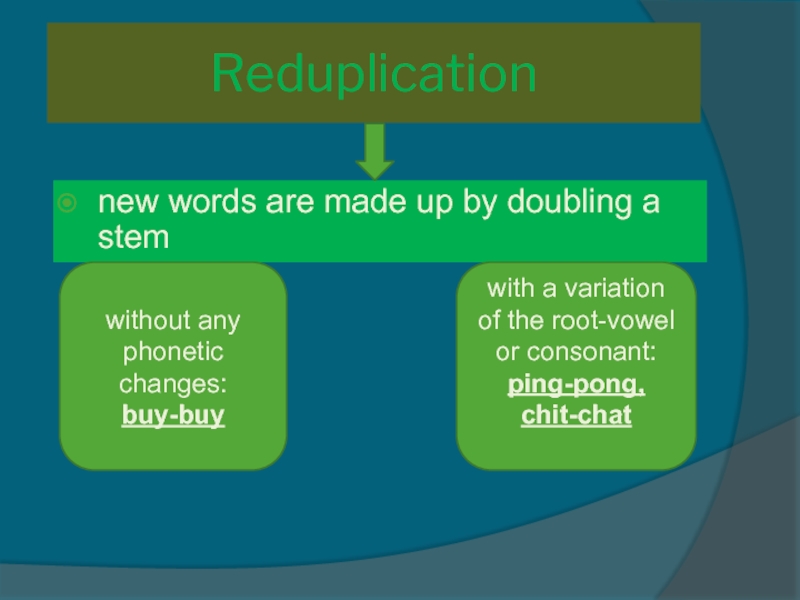
Слайд 7Back-formation
the derivation of new words by subtracting a real or
supposed affix from existing words through misinterpretation of their structure
Affix
–er
Paint-er from to paint
a verb was produced from a noun by subtraction
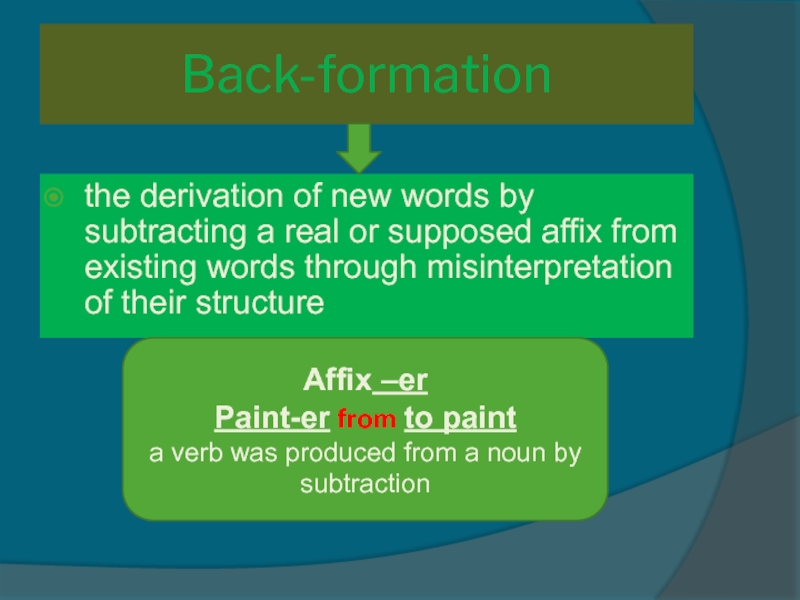
Слайд 8Sound-interchange
a change of a phoneme in a morpheme resulting in
a new lexical meaning
Song – to sing, food – feed
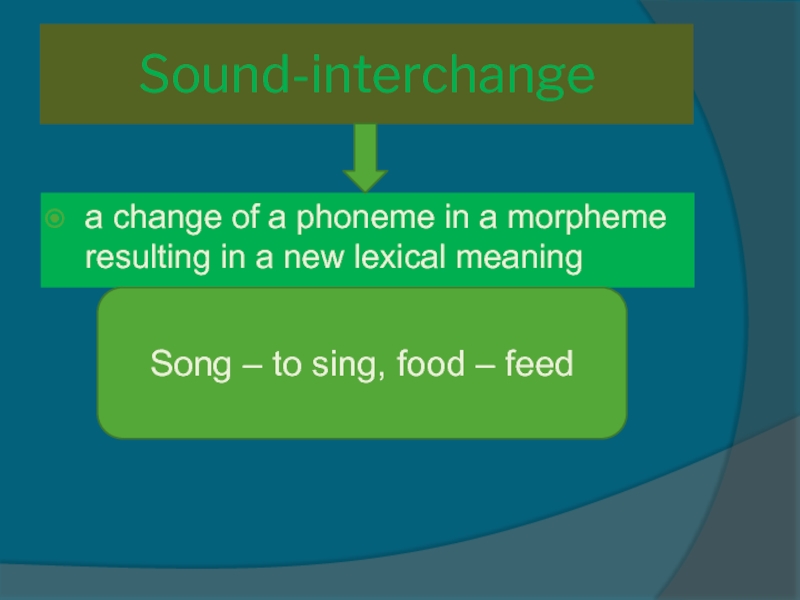
Слайд 9The stress distinction
For example
’Conduct (n)
(behavior) – con’duct (v) (to lead or guide in a
formal way)
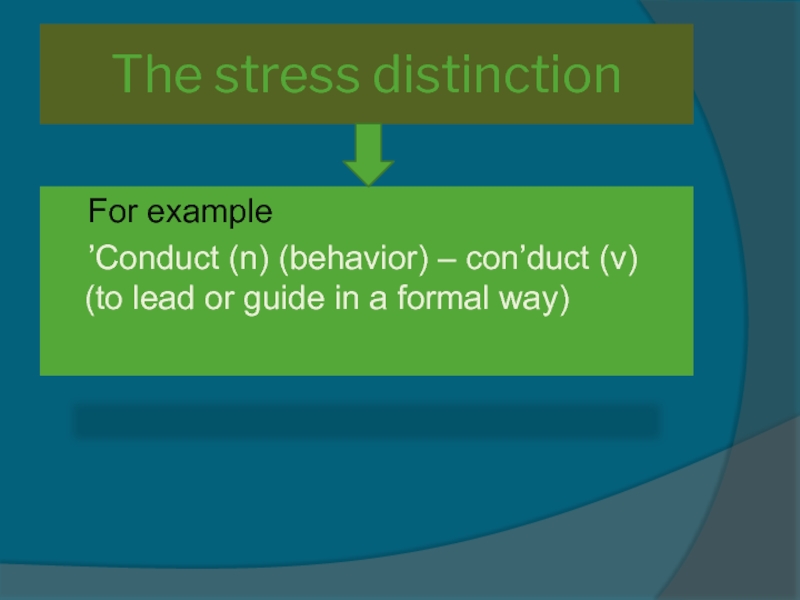
The ‘Word Formation Process’ is regarded as the branch of Morphology, and it has a significant role in expanding the vocabulary that helps us communicate very smoothly. The main objectives of the word-formation process are to form new words with the same root by deploying different rules or processes.
In other words, we can say that the word-formation process is a process in which new words are formed by modifying the existing terms or completely changing those words.
Let us see the fundamental word-formation processes in linguistics:
Derivation
‘Derivation’ is a significant word-formation process that attaches derivation affixes to the main form to create a new word. Affixes (prefixes or suffixes) are regarded as bound morphemes.
A morpheme is the smallest meaningful syntactical or grammar unit of a language that cannot be divided without changing its meaning. In contrast to the free morpheme, a bound morpheme doesn’t have any independent meaning, and it needs the help of a free morpheme to form a new word.
Let us see some examples of derivation in the below table:
| Base Forms | New Words |
| Appear | Disappear |
| Justice | Injustice |
| Lighten | Enlighten |
| Friend | Friendship |
| Happy | Happiness |
Back Formation
‘Back-Formation’ is a word-formation process that eliminates the actual derivational affix from the main form to create a new word. However, Back-Formation is contrary to derivation in terms of forming new words. Let us see some examples of Back-Formation in the below table:
| Base Forms | Back Formation |
| Insertion | Insert |
| Donation | Donate |
| Precession | Process |
| Obsessive | Obsess |
| Resurrection | Resurrect |
Conversion
In conversion, a word of one grammatical form converts into another without changing spelling or pronunciation. For example, the term ‘Google’ originated as a noun before the verb.
A few years ago, we only used the term as a noun (search it on Google), but now we say ‘Google it. Let us see some examples of conversion in the below table:
| Noun | To Verb |
| Access | – to access |
| – to google | |
| – to email | |
| Name | – to name |
| Host | – to host |
| Verb | To Noun |
| To hope | Hope |
| To cover | Cover |
| To increase | Increase |
| To attack | Attack |
Compounding
‘Compounding’ is a word-formation process that allows words to combine to make a new word. Compounding words can be formed as two words joined with a hyphen. Let us see some examples in the below table:
| Words | Compounding Words |
| Class+room | Classroom |
| Note+book | Notebook |
| Break+up | Breakup |
| Brother+in+law | Brother in law |
| High+light | Highlight |
Clipping
‘Clipping’ is another essential word-formation process that reduces or shortens a word without changing the exact meaning. In contrast to the back-formation process, it reserves the original meaning.
Clipping is divided into four types. They are:
- Back Clipping
- Fore Clipping
- Middle Clipping
- Complex Clipping
Every Clipping has different roles in words when they are assigned. Back Clipping removes the end part of a word; Fore Clipping removes the beginning part of a word; Middle Clipping reserves the middle position. Finally, Complex Clipping removes multiple pieces from multiple words.
Let us see some examples in the below table:
| Words | Clippings |
| Advertisement | Ad |
| Photograph | Photo |
| Telephone | Phone |
| Influenza | Flue |
| Cabletelegram | Cablegram |
Blending
In the ‘Blending’ word-formation method, the parts of two or more words combine to form a new word. Let us see some examples in the below table:
| Words | Blendings |
| Breakfast+lunch | Brunch |
| Biographical+picture | Biopic |
| Motor+hotel | Motel |
| Spanish+English | Spanglish |
| Telephone+marathon | Telethon |
Abbreviation
‘Abbreviation’ is another famous and widely used word-formation method used to shorten a word or phrase. In the modern era, ‘Abbreviation is becoming more popular. Nowadays, people used to use it everywhere. Let us see some examples in the below table:
| Words/Phrases | Abbreviation |
| Junior | Jr. |
| Mister | Mr. |
| Mistress | Miss. |
| Doctor | Dr. |
| Department | Dept. |
| Bachelor of Arts | B.A. |
| Master of Arts | M.A. |
| Master of Business Administration | MBA |
Acronyms
An Acronym is a popular word-formation process in which an initialism is pronounced as a word. It forms from the first letter of each word in a phrase, and the newly formed letters create a new word that helps us speedy communication. For example, ‘PIN’ is an initialism for Personal Identification Number used as the word ‘pin.’
However, let us see some other famous examples of acronyms in the below table for a better understanding:
| Acronyms | Words/Phrases |
| HIV | Human Immunodeficiency Virus |
| AIDS | Acquired Immunodeficiency Syndrome |
| NASA | National Aeronautics and Space Administration |
| ASAP | As Soon As Possible |
| AWOL | Absent Without Leave |
Borrowing
‘Borrowing’ is another word-formation process in which a word from one language is borrowed directly into another language. Let us see some English words which are borrowed from another language:
| Algebra | Arabic |
| Cherub | Hebrew |
| Murder | French |
| Pizza | Italian |
| Tamale | Spanish |
Conclusion
Now we know that Word-Formation Processes are the methods by which words are formed by deploying different types of rules. We can create new words by following the above word-formation methods.
We need to do one thing: we have to follow the fundamental rules or processes of word formation.
Azizul Hakim is the founder & CEO of englishfinders.com. He is a passionate writer, English instructor, and content creator. He has completed his graduation and post-graduation in English language and literature.
Wiki User
∙ 6y ago
Want this question answered?
Be notified when an answer is posted
Study guides
Add your answer:
Earn +
20
pts
Q: What is a word that comes from two words to form one word?
Write your answer…
Submit
Still have questions?
Related questions
People also asked
Lecture №3. Productive and Non-productive Ways of Word-formation in Modern English
Productivity is the ability to form new words after existing patterns which are readily understood by the speakers of language. The most important and the most productive ways of word-formation are affixation, conversion, word-composition and abbreviation (contraction). In the course of time the productivity of this or that way of word-formation may change. Sound interchange or gradation (blood-to bleed, to abide-abode, to strike-stroke) was a productive way of word building in old English and is important for a diachronic study of the English language. It has lost its productivity in Modern English and no new word can be coined by means of sound gradation. Affixation on the contrary was productive in Old English and is still one of the most productive ways of word building in Modern English.
WORDBUILDING
Word-building is one of the main ways of enriching vocabulary. There are four main ways of word-building in modern English: affixation, composition, conversion, abbreviation. There are also secondary ways of word-building: sound interchange, stress interchange, sound imitation, blends, back formation.
AFFIXATION
Affixation is one of the most productive ways of word-building throughout the history of English. It consists in adding an affix to the stem of a definite part of speech. Affixation is divided into suffixation and prefixation.
Suffixation
The main function of suffixes in Modern English is to form one part of speech from another, the secondary function is to change the lexical meaning of the same part of speech. (e.g. «educate» is a verb, «educator» is a noun, and music» is a noun, «musical» is also a noun or an adjective). There are different classifications of suffixes :
1. Part-of-speech classification. Suffixes which can form different parts of speech are given here :
a) noun-forming suffixes, such as: —er (criticizer), —dom (officialdom), —ism (ageism),
b) adjective-forming suffixes, such as: —able (breathable), less (symptomless), —ous (prestigious),
c) verb-forming suffixes, such as —ize (computerize) , —ify (minify),
d) adverb-forming suffixes , such as : —ly (singly), —ward (tableward),
e) numeral-forming suffixes, such as —teen (sixteen), —ty (seventy).
2. Semantic classification. Suffixes changing the lexical meaning of the stem can be subdivided into groups, e.g. noun-forming suffixes can denote:
a) the agent of the action, e.g. —er (experimenter), —ist (taxist), -ent (student),
b) nationality, e.g. —ian (Russian), —ese (Japanese), —ish (English),
c) collectivity, e.g. —dom (moviedom), —ry (peasantry, —ship (readership), —ati (literati),
d) diminutiveness, e.g. —ie (horsie), —let (booklet), —ling (gooseling), —ette (kitchenette),
e) quality, e.g. —ness (copelessness), —ity (answerability).
3. Lexico—grammatical character of the stem. Suffixes which can be added to certain groups of stems are subdivided into:
a) suffixes added to verbal stems, such as: —er (commuter), —ing (suffering), — able (flyable), —ment (involvement), —ation (computerization),
b) suffixes added to noun stems, such as: —less (smogless), —ful (roomful), —ism (adventurism), —ster (pollster), —nik (filmnik), —ish (childish),
c) suffixes added to adjective stems, such as: —en (weaken), —ly (pinkly), —ish (longish), —ness (clannishness).
4. Origin of suffixes. Here we can point out the following groups:
a) native (Germanic), such as —er,-ful, —less, —ly.
b) Romanic, such as : —tion, —ment, —able, —eer.
c) Greek, such as : —ist, —ism, -ize.
d) Russian, such as —nik.
5. Productivity. Here we can point out the following groups:
a) productive, such as: —er, —ize, —ly, —ness.
b) semi-productive, such as: —eer, —ette, —ward.
c) non-productive , such as: —ard (drunkard), —th (length).
Suffixes can be polysemantic, such as: —er can form nouns with the following meanings: agent, doer of the action expressed by the stem (speaker), profession, occupation (teacher), a device, a tool (transmitter). While speaking about suffixes we should also mention compound suffixes which are added to the stem at the same time, such as —ably, —ibly, (terribly, reasonably), —ation (adaptation from adapt). There are also disputable cases whether we have a suffix or a root morpheme in the structure of a word, in such cases we call such morphemes semi-suffixes, and words with such suffixes can be classified either as derived words or as compound words, e.g. —gate (Irangate), —burger (cheeseburger), —aholic (workaholic) etc.
Prefixation
Prefixation is the formation of words by means of adding a prefix to the stem. In English it is characteristic for forming verbs. Prefixes are more independent than suffixes. Prefixes can be classified according to the nature of words in which they are used: prefixes used in notional words and prefixes used in functional words. Prefixes used in notional words are proper prefixes which are bound morphemes, e.g. un— (unhappy). Prefixes used in functional words are semi-bound morphemes because they are met in the language as words, e.g. over— (overhead) (cf. over the table). The main function of prefixes in English is to change the lexical meaning of the same part of speech. But the recent research showed that about twenty-five prefixes in Modern English form one part of speech from another (bebutton, interfamily, postcollege etc).
Prefixes can be classified according to different principles:
1. Semantic classification:
a) prefixes of negative meaning, such as: in— (invaluable), non— (nonformals), un— (unfree) etc,
b) prefixes denoting repetition or reversal actions, such as: de— (decolonize), re— (revegetation), dis— (disconnect),
c) prefixes denoting time, space, degree relations, such as: inter— (interplanetary) , hyper— (hypertension), ex— (ex-student), pre— (pre-election), over— (overdrugging) etc.
2. Origin of prefixes:
a) native (Germanic), such as: un-, over-, under— etc.
b) Romanic, such as: in-, de-, ex-, re— etc.
c) Greek, such as: sym-, hyper— etc.
When we analyze such words as adverb, accompany where we can find the root of the word (verb, company) we may treat ad-, ac— as prefixes though they were never used as prefixes to form new words in English and were borrowed from Romanic languages together with words. In such cases we can treat them as derived words. But some scientists treat them as simple words. Another group of words with a disputable structure are such as: contain, retain, detain and conceive, receive, deceive where we can see that re-, de-, con— act as prefixes and —tain, —ceive can be understood as roots. But in English these combinations of sounds have no lexical meaning and are called pseudo-morphemes. Some scientists treat such words as simple words, others as derived ones. There are some prefixes which can be treated as root morphemes by some scientists, e.g. after— in the word afternoon. American lexicographers working on Webster dictionaries treat such words as compound words. British lexicographers treat such words as derived ones.
COMPOSITION
Composition is the way of word building when a word is formed by joining two or more stems to form one word. The structural unity of a compound word depends upon: a) the unity of stress, b) solid or hyphеnated spelling, c) semantic unity, d) unity of morphological and syntactical functioning. These are characteristic features of compound words in all languages. For English compounds some of these factors are not very reliable. As a rule English compounds have one uniting stress (usually on the first component), e.g. hard-cover, best—seller. We can also have a double stress in an English compound, with the main stress on the first component and with a secondary stress on the second component, e.g. blood—vessel. The third pattern of stresses is two level stresses, e.g. snow—white, sky—blue. The third pattern is easily mixed up with word-groups unless they have solid or hyphеnated spelling.
Spelling in English compounds is not very reliable as well because they can have different spelling even in the same text, e.g. war—ship, blood—vessel can be spelt through a hyphen and also with a break, insofar, underfoot can be spelt solidly and with a break. All the more so that there has appeared in Modern English a special type of compound words which are called block compounds, they have one uniting stress but are spelt with a break, e.g. air piracy, cargo module, coin change, penguin suit etc. The semantic unity of a compound word is often very strong. In such cases we have idiomatic compounds where the meaning of the whole is not a sum of meanings of its components, e.g. to ghostwrite, skinhead, brain—drain etc. In nonidiomatic compounds semantic unity is not strong, e. g., airbus, to bloodtransfuse, astrodynamics etc.
English compounds have the unity of morphological and syntactical functioning. They are used in a sentence as one part of it and only one component changes grammatically, e.g. These girls are chatter-boxes. «Chatter-boxes» is a predicative in the sentence and only the second component changes grammatically. There are two characteristic features of English compounds:
a) Both components in an English compound are free stems, that is they can be used as words with a distinctive meaning of their own. The sound pattern will be the same except for the stresses, e.g. «a green-house» and «a green house». Whereas for example in Russian compounds the stems are bound morphemes, as a rule.
b) English compounds have a two-stem pattern, with the exception of compound words which have form-word stems in their structure, e.g. middle-of-the-road, off—the—record, up—and—doing etc. The two-stem pattern distinguishes English compounds from German ones.
WAYS OF FORMING COMPOUND WORDS
Compound words in English can be formed not only by means of composition but also by means of:
a) reduplication, e.g. too—too, and also by means of reduplication combined with sound interchange , e.g. rope-ripe,
b) conversion from word-groups, e.g. to micky—mouse, can—do, makeup etc,
c) back formation from compound nouns or word-groups, e.g. to bloodtransfuse, to fingerprint etc ,
d) analogy, e.g. lie—in (on the analogy with sit-in) and also phone—in, brawn—drain (on the analogy with brain—drain) etc.
CLASSIFICATIONS OF ENGLISH COMPOUNDS
1. According to the parts of speech compounds are subdivided into:
a) nouns, such as: baby-moon, globe-trotter,
b) adjectives, such as : free-for-all, power-happy,
c) verbs, such as : to honey-moon, to baby-sit, to henpeck,
d) adverbs, such as: downdeep, headfirst,
e) prepositions, such as: into, within,
f) numerals, such as : fifty—five.
2. According to the way components are joined together compounds are divided into: a) neutral, which are formed by joining together two stems without any joining morpheme, e.g. ball—point, to windowshop,
b) morphological where components are joined by a linking element: vowels «o» or «i» or the consonant «s», e.g. («astrospace», «handicraft», «sportsman»),
c) syntactical where the components are joined by means of form-word stems, e.g. here-and-now, free-for-all, do-or-die.
3. According to their structure compounds are subdivided into:
a) compound words proper which consist of two stems, e.g. to job-hunt, train-sick, go-go, tip-top,
b) derivational compounds, where besides the stems we have affixes, e.g. ear—minded, hydro-skimmer,
c) compound words consisting of three or more stems, e.g. cornflower—blue, eggshell—thin, singer—songwriter,
d) compound-shortened words, e.g. boatel, VJ—day, motocross, intervision, Eurodollar, Camford.
4. According to the relations between the components compound words are subdivided into:
a) subordinative compounds where one of the components is the semantic and the structural centre and the second component is subordinate; these subordinative relations can be different: with comparative relations, e.g. honey—sweet, eggshell—thin, with limiting relations, e.g. breast—high, knee—deep, with emphatic relations, e.g. dog—cheap, with objective relations, e.g. gold—rich, with cause relations, e.g. love—sick, with space relations, e.g. top—heavy, with time relations, e.g. spring—fresh, with subjective relations, e.g. foot—sore etc
b) coordinative compounds where both components are semantically independent. Here belong such compounds when one person (object) has two functions, e.g. secretary-stenographer, woman-doctor, Oxbridge etc. Such compounds are called additive. This group includes also compounds formed by means of reduplication, e.g. fifty-fifty, no-no, and also compounds formed with the help of rhythmic stems (reduplication combined with sound interchange) e.g. criss-cross, walkie-talkie.
5. According to the order of the components compounds are divided into compounds with direct order, e.g. kill—joy, and compounds with indirect order, e.g. nuclear—free, rope—ripe.
CONVERSION
Conversion is a characteristic feature of the English word-building system. It is also called affixless derivation or zero-suffixation. The term «conversion» first appeared in the book by Henry Sweet «New English Grammar» in 1891. Conversion is treated differently by different scientists, e.g. prof. A.I. Smirntitsky treats conversion as a morphological way of forming words when one part of speech is formed from another part of speech by changing its paradigm, e.g. to form the verb «to dial» from the noun «dial» we change the paradigm of the noun (a dial, dials) for the paradigm of a regular verb (I dial, he dials, dialed, dialing). A. Marchand in his book «The Categories and Types of Present-day English» treats conversion as a morphological-syntactical word-building because we have not only the change of the paradigm, but also the change of the syntactic function, e.g. I need some good paper for my room. (The noun «paper» is an object in the sentence). I paper my room every year. (The verb «paper» is the predicate in the sentence). Conversion is the main way of forming verbs in Modern English. Verbs can be formed from nouns of different semantic groups and have different meanings because of that, e.g.:
a) verbs have instrumental meaning if they are formed from nouns denoting parts of a human body e.g. to eye, to finger, to elbow, to shoulder etc. They have instrumental meaning if they are formed from nouns denoting tools, machines, instruments, weapons, e.g. to hammer, to machine-gun, to rifle, to nail,
b) verbs can denote an action characteristic of the living being denoted by the noun from which they have been converted, e.g. to crowd, to wolf, to ape,
c) verbs can denote acquisition, addition or deprivation if they are formed from nouns denoting an object, e.g. to fish, to dust, to peel, to paper,
d) verbs can denote an action performed at the place denoted by the noun from which they have been converted, e.g. to park, to garage, to bottle, to corner, to pocket,
e) verbs can denote an action performed at the time denoted by the noun from which they have been converted e.g. to winter, to week-end.
Verbs can be also converted from adjectives, in such cases they denote the change of the state, e.g. to tame (to become or make tame), to clean, to slim etc.
Nouns can also be formed by means of conversion from verbs. Converted nouns can denote: a) instant of an action e.g. a jump, a move,
b) process or state e.g. sleep, walk,
c) agent of the action expressed by the verb from which the noun has been converted, e.g. a help, a flirt, a scold,
d) object or result of the action expressed by the verb from which the noun has been converted, e.g. a burn, a find, a purchase,
e) place of the action expressed by the verb from which the noun has been converted, e.g. a drive, a stop, a walk.
Many nouns converted from verbs can be used only in the Singular form and denote momentaneous actions. In such cases we have partial conversion. Such deverbal nouns are often used with such verbs as: to have, to get, to take etc., e.g. to have a try, to give a push, to take a swim.
CRITERIA OF SEMANTIC DERIVATION
In cases of conversion the problem of criteria of semantic derivation arises: which of the converted pair is primary and which is converted from it. The problem was first analized by prof. A.I. Smirnitsky. Later on P.A. Soboleva developed his idea and worked out the following criteria:
1. If the lexical meaning of the root morpheme and the lexico-grammatical meaning of the stem coincide the word is primary, e.g. in cases pen — to pen, father — to father the nouns are names of an object and a living being. Therefore in the nouns «pen» and «father» the lexical meaning of the root and the lexico-grammatical meaning of the stem coincide. The verbs «to pen» and «to father» denote an action, a process therefore the lexico-grammatical meanings of the stems do not coincide with the lexical meanings of the roots. The verbs have a complex semantic structure and they were converted from nouns.
2. If we compare a converted pair with a synonymic word pair which was formed by means of suffixation we can find out which of the pair is primary. This criterion can be applied only to nouns converted from verbs, e.g. «chat» n. and «chat» v. can be compared with «conversation» – «converse».
3. The criterion based on derivational relations is of more universal character. In this case we must take a word-cluster of relative words to which the converted pair belongs. If the root stem of the word-cluster has suffixes added to a noun stem the noun is primary in the converted pair and vica versa, e.g. in the word-cluster: hand n., hand v., handy, handful the derived words have suffixes added to a noun stem, that is why the noun is primary and the verb is converted from it. In the word-cluster: dance n., dance v., dancer, dancing we see that the primary word is a verb and the noun is converted from it.
SUBSTANTIVIZATION OF ADJECTIVES
Some scientists (Yespersen, Kruisinga) refer substantivization of adjectives to conversion. But most scientists disagree with them because in cases of substantivization of adjectives we have quite different changes in the language. Substantivization is the result of ellipsis (syntactical shortening) when a word combination with a semantically strong attribute loses its semantically weak noun (man, person etc), e.g. «a grown-up person» is shortened to «a grown-up». In cases of perfect substantivization the attribute takes the paradigm of a countable noun, e.g. a criminal, criminals, a criminal’s (mistake), criminals’ (mistakes). Such words are used in a sentence in the same function as nouns, e.g. I am fond of musicals. (musical comedies). There are also two types of partly substantivized adjectives: 1) those which have only the plural form and have the meaning of collective nouns, such as: sweets, news, finals, greens; 2) those which have only the singular form and are used with the definite article. They also have the meaning of collective nouns and denote a class, a nationality, a group of people, e.g. the rich, the English, the dead.
«STONE WALL» COMBINATIONS
The problem whether adjectives can be formed by means of conversion from nouns is the subject of many discussions. In Modern English there are a lot of word combinations of the type, e.g. price rise, wage freeze, steel helmet, sand castle etc. If the first component of such units is an adjective converted from a noun, combinations of this type are free word-groups typical of English (adjective + noun). This point of view is proved by O. Yespersen by the following facts:
1. «Stone» denotes some quality of the noun «wall».
2. «Stone» stands before the word it modifies, as adjectives in the function of an attribute do in English.
3. «Stone» is used in the Singular though its meaning in most cases is plural, and adjectives in English have no plural form.
4. There are some cases when the first component is used in the Comparative or the Superlative degree, e.g. the bottomest end of the scale.
5. The first component can have an adverb which characterizes it, and adjectives are characterized by adverbs, e.g. a purely family gathering.
6. The first component can be used in the same syntactical function with a proper adjective to characterize the same noun, e.g. lonely bare stone houses.
7. After the first component the pronoun «one» can be used instead of a noun, e.g. I shall not put on a silk dress, I shall put on a cotton one.
However Henry Sweet and some other scientists say that these criteria are not characteristic of the majority of such units. They consider the first component of such units to be a noun in the function of an attribute because in Modern English almost all parts of speech and even word-groups and sentences can be used in the function of an attribute, e.g. the then president (an adverb), out-of-the-way villages (a word-group), a devil-may-care speed (a sentence). There are different semantic relations between the components of «stone wall» combinations. E.I. Chapnik classified them into the following groups:
1. time relations, e.g. evening paper,
2. space relations, e.g. top floor,
3. relations between the object and the material of which it is made, e.g. steel helmet,
4. cause relations, e.g. war orphan,
5. relations between a part and the whole, e.g. a crew member,
6. relations between the object and an action, e.g. arms production,
7. relations between the agent and an action e.g. government threat, price rise,
8. relations between the object and its designation, e.g. reception hall,
9. the first component denotes the head, organizer of the characterized object, e.g. Clinton government, Forsyte family,
10. the first component denotes the field of activity of the second component, e.g. language teacher, psychiatry doctor,
11. comparative relations, e.g. moon face,
12. qualitative relations, e.g. winter apples.
ABBREVIATION
In the process of communication words and word-groups can be shortened. The causes of shortening can be linguistic and extra-linguistic. By extra-linguistic causes changes in the life of people are meant. In Modern English many new abbreviations, acronyms, initials, blends are formed because the tempo of life is increasing and it becomes necessary to give more and more information in the shortest possible time. There are also linguistic causes of abbreviating words and word-groups, such as the demand of rhythm, which is satisfied in English by monosyllabic words. When borrowings from other languages are assimilated in English they are shortened. Here we have modification of form on the basis of analogy, e.g. the Latin borrowing «fanaticus» is shortened to «fan» on the analogy with native words: man, pan, tan etc. There are two main types of shortenings: graphical and lexical.
Graphical abbreviations
Graphical abbreviations are the result of shortening of words and word-groups only in written speech while orally the corresponding full forms are used. They are used for the economy of space and effort in writing. The oldest group of graphical abbreviations in English is of Latin origin. In Russian this type of abbreviation is not typical. In these abbreviations in the spelling Latin words are shortened, while orally the corresponding English equivalents are pronounced in the full form, e.g. for example (Latin exampli gratia), a.m. – in the morning (ante meridiem), No – number (numero), p.a. – a year (per annum), d – penny (dinarius), lb – pound (libra), i. e. – that is (id est) etc.
Some graphical abbreviations of Latin origin have different English equivalents in different contexts, e.g. p.m. can be pronounced «in the afternoon» (post meridiem) and «after death» (post mortem). There are also graphical abbreviations of native origin, where in the spelling we have abbreviations of words and word-groups of the corresponding English equivalents in the full form. We have several semantic groups of them: a) days of the week, e.g. Mon – Monday, Tue – Tuesday etc
b) names of months, e.g. Apr – April, Aug – August etc.
c) names of counties in UK, e.g. Yorks – Yorkshire, Berks – Berkshire etc
d) names of states in USA, e.g. Ala – Alabama, Alas – Alaska etc.
e) names of address, e.g. Mr., Mrs., Ms., Dr. etc.
f) military ranks, e.g. capt. – captain, col. – colonel, sgt – sergeant etc.
g) scientific degrees, e.g. B.A. – Bachelor of Arts, D.M. – Doctor of Medicine. (Sometimes in scientific degrees we have abbreviations of Latin origin, e.g., M.B. – Medicinae Baccalaurus).
h) units of time, length, weight, e.g. f./ft – foot/feet, sec. – second, in. – inch, mg. – milligram etc.
The reading of some graphical abbreviations depends on the context, e.g. «m» can be read as: male, married, masculine, metre, mile, million, minute, «l.p.» can be read as long-playing, low pressure.
Initial abbreviations
Initialisms are the bordering case between graphical and lexical abbreviations. When they appear in the language, as a rule, to denote some new offices they are closer to graphical abbreviations because orally full forms are used, e.g. J.V. – joint venture. When they are used for some duration of time they acquire the shortened form of pronouncing and become closer to lexical abbreviations, e.g. BBC is as a rule pronounced in the shortened form. In some cases the translation of initialisms is next to impossible without using special dictionaries. Initialisms are denoted in different ways. Very often they are expressed in the way they are pronounced in the language of their origin, e.g. ANZUS (Australia, New Zealand, United States) is given in Russian as АНЗУС, SALT (Strategic Arms Limitation Talks) was for a long time used in Russian as СОЛТ, now a translation variant is used (ОСВ – Договор об ограничении стратегических вооружений). This type of initialisms borrowed into other languages is preferable, e.g. UFO – НЛО, CП – JV etc. There are three types of initialisms in English:
a) initialisms with alphabetical reading, such as UK, BUP, CND etc
b) initialisms which are read as if they are words, e.g. UNESCO, UNO, NATO etc.
c) initialisms which coincide with English words in their sound form, such initialisms are called acronyms, e.g. CLASS (Computor-based Laboratory for Automated School System). Some scientists unite groups b) and c) into one group which they call acronyms. Some initialisms can form new words in which they act as root morphemes by different ways of wordbuilding:
a) affixation, e.g. AVALism, ex- POW, AIDSophobia etc.
b) conversion, e.g. to raff, to fly IFR (Instrument Flight Rules),
c) composition, e.g. STOLport, USAFman etc.
d) there are also compound-shortened words where the first component is an initial abbreviation with the alphabetical reading and the second one is a complete word, e.g. A-bomb, U-pronunciation, V -day etc. In some cases the first component is a complete word and the second component is an initial abbreviation with the alphabetical pronunciation, e.g. Three -Ds (Three dimensions) – стереофильм.
Abbreviations of words
Abbreviation of words consists in clipping a part of a word. As a result we get a new lexical unit where either the lexical meaning or the style is different form the full form of the word. In such cases as «fantasy» and «fancy», «fence» and «defence» we have different lexical meanings. In such cases as «laboratory» and «lab», we have different styles. Abbreviation does not change the part-of-speech meaning, as we have it in the case of conversion or affixation, it produces words belonging to the same part of speech as the primary word, e.g. prof. is a noun and professor is also a noun. Mostly nouns undergo abbreviation, but we can also meet abbreviation of verbs, such as to rev. from to revolve, to tab from to tabulate etc. But mostly abbreviated forms of verbs are formed by means of conversion from abbreviated nouns, e.g. to taxi, to vac etc. Adjectives can be abbreviated but they are mostly used in school slang and are combined with suffixation, e.g. comfy, dilly etc. As a rule pronouns, numerals, interjections. conjunctions are not abbreviated. The exceptions are: fif (fifteen), teen-ager, in one’s teens (apheresis from numerals from 13 to 19). Lexical abbreviations are classified according to the part of the word which is clipped. Mostly the end of the word is clipped, because the beginning of the word in most cases is the root and expresses the lexical meaning of the word. This type of abbreviation is called apocope. Here we can mention a group of words ending in «o», such as disco (dicotheque), expo (exposition), intro (introduction) and many others. On the analogy with these words there developed in Modern English a number of words where «o» is added as a kind of a suffix to the shortened form of the word, e.g. combo (combination) – небольшой эстрадный ансамбль, Afro (African) – прическа под африканца etc. In other cases the beginning of the word is clipped. In such cases we have apheresis, e.g. chute (parachute), varsity (university), copter (helicopter), thuse (enthuse) etc. Sometimes the middle of the word is clipped, e.g. mart (market), fanzine (fan magazine) maths (mathematics). Such abbreviations are called syncope. Sometimes we have a combination of apocope with apheresis, when the beginning and the end of the word are clipped, e.g. tec (detective), van (vanguard) etc. Sometimes shortening influences the spelling of the word, e.g. «c» can be substituted by «k» before «e» to preserve pronunciation, e.g. mike (microphone), Coke (coca-cola) etc. The same rule is observed in the following cases: fax (facsimile), teck (technical college), trank (tranquilizer) etc. The final consonants in the shortened forms are substituded by letters characteristic of native English words.
NON-PRODUCTIVE WAYS OF WORDBUILDING
SOUND INTERCHANGE
Sound interchange is the way of word-building when some sounds are changed to form a new word. It is non-productive in Modern English, it was productive in Old English and can be met in other Indo-European languages. The causes of sound interchange can be different. It can be the result of Ancient Ablaut which cannot be explained by the phonetic laws during the period of the language development known to scientists, e.g. to strike – stroke, to sing – song etc. It can be also the result of Ancient Umlaut or vowel mutation which is the result of palatalizing the root vowel because of the front vowel in the syllable coming after the root (regressive assimilation), e.g. hot — to heat (hotian), blood — to bleed (blodian) etc. In many cases we have vowel and consonant interchange. In nouns we have voiceless consonants and in verbs we have corresponding voiced consonants because in Old English these consonants in nouns were at the end of the word and in verbs in the intervocalic position, e.g. bath – to bathe, life – to live, breath – to breathe etc.
STRESS INTERCHANGE
Stress interchange can be mostly met in verbs and nouns of Romanic origin: nouns have the stress on the first syllable and verbs on the last syllable, e.g. `accent — to ac`cent. This phenomenon is explained in the following way: French verbs and nouns had different structure when they were borrowed into English, verbs had one syllable more than the corresponding nouns. When these borrowings were assimilated in English the stress in them was shifted to the previous syllable (the second from the end). Later on the last unstressed syllable in verbs borrowed from French was dropped (the same as in native verbs) and after that the stress in verbs was on the last syllable while in nouns it was on the first syllable. As a result of it we have such pairs in English as: to af«fix -`affix, to con`flict- `conflict, to ex`port -`export, to ex`tract — `extract etc. As a result of stress interchange we have also vowel interchange in such words because vowels are pronounced differently in stressed and unstressed positions.
SOUND IMITATION
It is the way of word-building when a word is formed by imitating different sounds. There are some semantic groups of words formed by means of sound imitation:
a) sounds produced by human beings, such as : to whisper, to giggle, to mumble, to sneeze, to whistle etc.
b) sounds produced by animals, birds, insects, such as: to hiss, to buzz, to bark, to moo, to twitter etc.
c) sounds produced by nature and objects, such as: to splash, to rustle, to clatter, to bubble, to ding-dong, to tinkle etc.
The corresponding nouns are formed by means of conversion, e.g. clang (of a bell), chatter (of children) etc.
BLENDS
Blends are words formed from a word-group or two synonyms. In blends two ways of word-building are combined: abbreviation and composition. To form a blend we clip the end of the first component (apocope) and the beginning of the second component (apheresis) . As a result we have a compound- shortened word. One of the first blends in English was the word «smog» from two synonyms: smoke and fog which means smoke mixed with fog. From the first component the beginning is taken, from the second one the end, «o» is common for both of them. Blends formed from two synonyms are: slanguage, to hustle, gasohol etc. Mostly blends are formed from a word-group, such as: acromania (acronym mania), cinemaddict (cinema adict), chunnel (channel, canal), dramedy (drama comedy), detectifiction (detective fiction), faction (fact fiction) (fiction based on real facts), informecial (information commercial), Medicare (medical care), magalog (magazine catalogue) slimnastics (slimming gymnastics), sociolite (social elite), slanguist (slang linguist) etc.
BACK FORMATION
It is the way of word-building when a word is formed by dropping the final morpheme to form a new word. It is opposite to suffixation, that is why it is called back formation. At first it appeared in the language as a result of misunderstanding the structure of a borrowed word. Prof. Yartseva explains this mistake by the influence of the whole system of the language on separate words. E.g. it is typical of English to form nouns denoting the agent of the action by adding the suffix -er to a verb stem (speak- speaker). So when the French word «beggar» was borrowed into English the final syllable «ar» was pronounced in the same way as the English —er and Englishmen formed the verb «to beg» by dropping the end of the noun. Other examples of back formation are: to accreditate (from accreditation), to bach (from bachelor), to collocate (from collocation), to enthuse (from enthusiasm), to compute (from computer), to emote (from emotion), to televise (from television) etc.
As we can notice in cases of back formation the part-of-speech meaning of the primary word is changed, verbs are formed from nouns.
23

